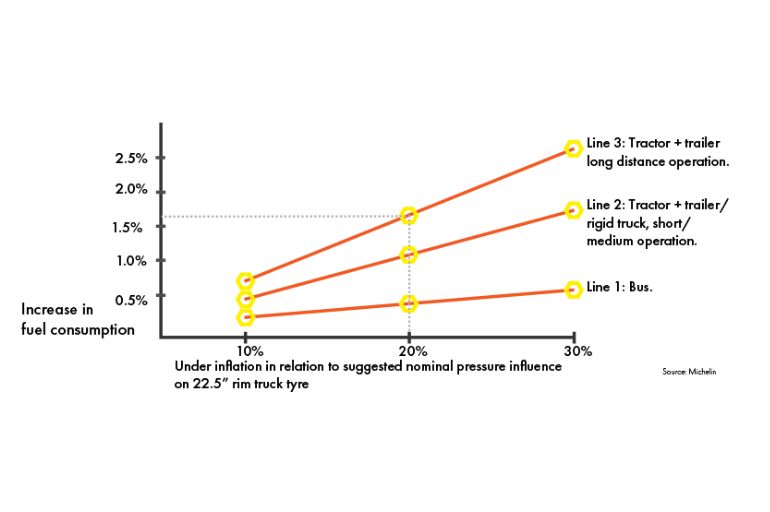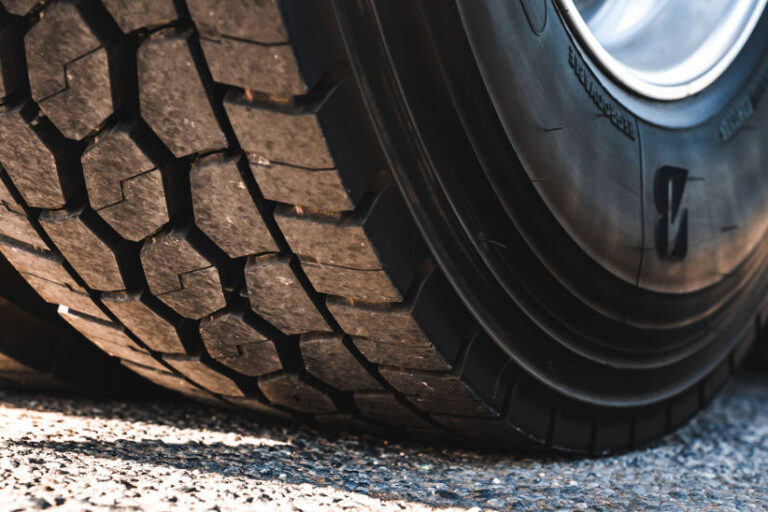Monitoring and maintaining your fleet’s tyre presures can have a dramatic impact on your bottom line, adding unnecessary costs to your business if they’re not regularly scrutinised.
While most fleet operators and managers will allocate a good deal of time and research into selecting the correct tyre, at the best price for their particular application, the critical part of ANY tyres performance and cost to a business is the air contained within it. This air can sometimes be overlooked, particularly with vehicles that operate remotely from a fleets main depot or workshop, and vehicles that cover large distances between workshop visits.
Impacts on safety
Improperly maintained tyre pressures have many adverse effects on a truck’s ability to be operated in a safe manner.
While overinflation does occur, and it too can have negative impacts, it is not as common as underinflation. Leaky valves, pressure losses over time and foreign object penetration are the main causes of underinflation and left unchecked can cause many safety issues.
The risk of, instant uncontrolled deflation or “blowout” of the tyre, increased braking distances, adverse effects on ABS sytems and overall dynamic instability of the vehicle. Body roll, load shift and poor directional control, can all potentially be attributed to poorly maintained tyre pressures resulting in underinflation.
Burning Cash
Under inflation results in a larger tyre footprint on the road, which in turn increases the tyres rolling resistance and drag. This can increase operating costs as the engine must work harder to rotate the underinflated tyres, (think: pushing a heavy wheel barrow with a partially flat tyre, hard work, right?), subsequently burning more fuel and also increasing emissions.
Excessive heat is also generated by under inflated tyres, resulting in the breaking down and degradation of a tyres material, this heat adversely affects the structural integrity of a tyre, particularly in the sidewall and shoulder area.
If part of your fleet maintenance plan is to re-cap/re-groove tyres, the news is not good either. Tyre casings are subject to testing before being recapped or re-grooved, while damage may not be visible to the eye, in depth electronic analysis can pick up anomalies in tyres subjected to excessive heat. This may result in the case not achieving its multi-use life, further increasing CO2 emissions, (more tyres need to be manufactured.)
How can pressures be pro-actively managed?
At each shift’s commencement, drivers pre-start checks (if they are diligently carrying them out) will usually consist of a visual inspection of tyres for damage and a “boot-kick” pressure check. While this method may identify a completely flat tyre, for many this method of checking will not likely alert the kicker to a 20% drop in tyre pressure.
Drivers should be the first line of defense in identifying potential problems with tyre pressures. “Good operators” can notice an increased tyre footprint, or a difference in the sound or feel of a tyre kicked with a boot or hit with a steel bar, but good operators can be a bit thin on the ground at times, so external management is best.
Most quality tyre service outlets will have tyre condition and pressure monitoring options for fleets. A tyre technician can usually be booked to periodically attend a yard at a time that sees the bulk of a fleet parked up. Regular checks such as this should yield financial benefits far in excess of this services cost, through reduced fuel consumption and lesser incidence of complete tyre failures and associated downtime, although admittedly this can be difficult to quantify.
There are many tyre monitoring and inflation systems available, both aftermarket and OE fitted which can be considered. These systems allow instant pressure displays from the driver’s seat. These can provide real time monitoring including operating temperature pressure checking, quickly identifying a problem before it becomes a failure.
Additional benefits these systems provide are that most systems can re-inflate a tyre that may have deflated overnight then maintain a pre-set pressure, allowing the operator to defer the tyre repair to later in the shift, at a more practical time and location (slow leaks only.)
In summary
Regular, routine monitoring of tyre inflation pressures, either manually or electronically, undoubtably benefits fleet operations in many ways. Increased safety to all road users should be paramount and front of mind, but the financial benefits cannot be understated.
Maximum life-span and longevity from a tyres first life to any future tyre life (re-capping/grooving) are on offer to astute operators and managers willing to “manage the pressure.”







